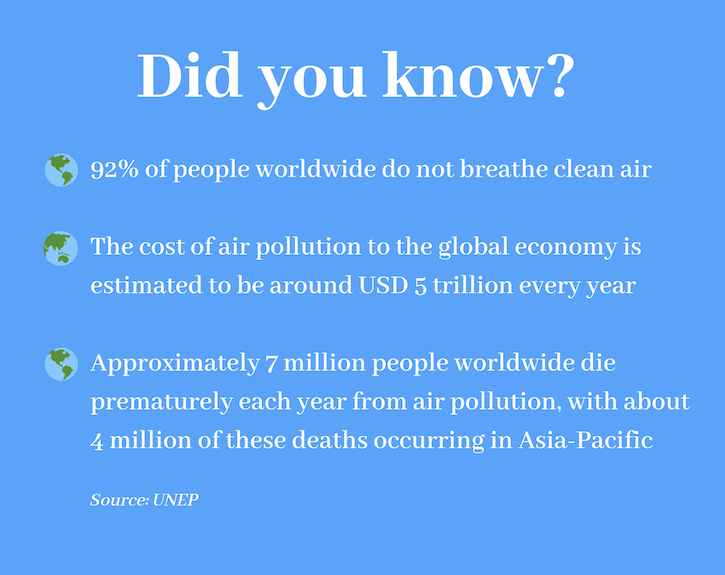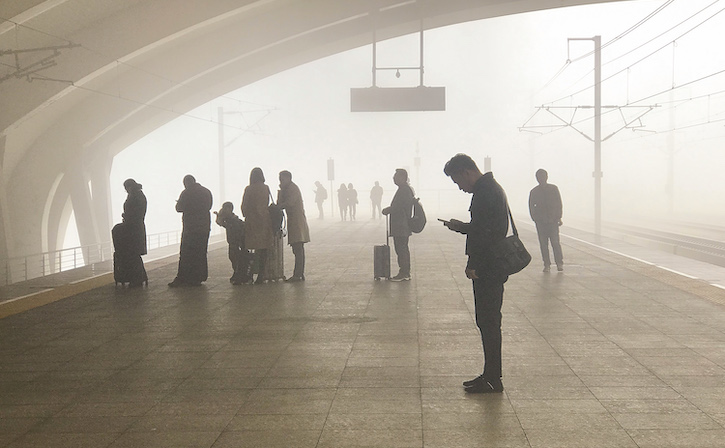
Today, China is hosting World Environment Day, focusing on air pollution. The intention is to highlight the significant impact of air pollution worldwide and to urge governments, industry, communities and individuals to work together to improve air quality in cities and regions across the world.
Why does air pollution occur?
Globally, air pollution has become a major health concern. 92% of people worldwide are not breathing clean air and approximately 7 million people worldwide die prematurely each year from the impacts of air pollution, with about 4 million of these deaths occurring in Asia-Pacific.
 The manufacturing of everyday goods, such as smart phones, washing machines and cars, requires significant energy use. Generating the energy needed to power economic activity, in particular the burning of fossil fuels such as coal, causes harmful pollutants to be emitted to the atmosphere.
The manufacturing of everyday goods, such as smart phones, washing machines and cars, requires significant energy use. Generating the energy needed to power economic activity, in particular the burning of fossil fuels such as coal, causes harmful pollutants to be emitted to the atmosphere.
Often there is no direct cost to a manufacturer to pollute the air, and thus there is little economic incentive for that company to spend money to reduce its environmental impact. The costs of pollution are instead passed on to society and the environment in the form of health costs and environmental degradation. In economics, these costs are called “externalities.”
Air pollution is an example of a negative externality. Because the costs to the environment and society of pollution are not paid by the producer (for example, a power station), the retail price of energy is lower than it technically should be, resulting in higher consumer demand and higher production. This means there is a greater environmental cost to production than is economically efficient. The inefficient allocation of resources caused by not accounting for externalities is often described as “market failure.” Many countries, including the United States, United Kingdom, China and India have faced serious air pollution during their development phases.
How do we address externalities and correct market failure?
There are several ways to address the issue of externalities. Two of the most common policies are:
- Standards (safety or technology): a legal form of regulation that limits how much pollutant a company or facility can emit. Authorities regulate behavior directly by dictating a maximum level of pollution that a factory may emit (known as a safety standard), or by requiring firms to impose the adoption of technologies for reducing emissions (a technology standard). Although very simple, this type of regulation is sometimes criticised as being too inflexible, as it imposes the same costs on each company or facility, regardless of the actual cost of reducing pollution.
- Incentive-based regulation (e.g. tradable emissions right): a more flexible, but more complex system that sets the total amount of pollution acceptable but leaves companies and facilities to work out the cheapest way to achieve the overall target. Those who find it cheaper to reduce pollution are incentivized to ‘over-achieve’ and sell the credits to those who find it relatively expensive to make reductions themselves. This kind of system is more economically efficient, but often more complex to manage.

China’s Air Pollution Timeline
It is well documented that China is facing multiple and serious environmental problems due to its recent rapid industrialization, including chronic air pollution in many of its major cities. In recent years, the government has been using a range of measures to try to improve the country’s air quality:
- September 2013: The State Council releases its Action Plan for Air Pollution Prevention and Control (2013-2017), focusing on reducing levels of PM2.5 and including funding of USD 277 billion
- March 2014: Premier Li Keqiang declares “war on pollution” at the annual National People’s Congress
- April 2014: Amendments are made to the Environment Protection Law to strengthen compliance and enforcement
- July 2018: China releases a new 2018-2020 Three-year Action Plan for Winning the Blue Sky War
These measures have helped China to make significant improvements to air quality. The 2013 Action Plan set PM2.5 targets for key regions, requiring significant reductions between 2013 and 2017 – for example, 15% in the Pearl River Delta and 33% in Beijing.
To meet these targets, Beijing has used direct regulatory measures, such as closing coal-fired power plants, and restricting coal burning for heating purposes. Nevertheless, these measures enabled the city to achieve a 35% reduction in annual average PM2.5. By 2017, China’s three biggest city clusters (Beijing-Tianjin-Hebei, and the Pearl and Yangtze deltas) had all beat their targets.
However, despite this progress, no Chinese city has yet reached the World Health Organization’s recommended annual average PM2.5 level of 10µg/m³. According to Greenpeace, as of the end of 2017, only 107 of China’s 338 cities of prefectural level or higher had reached the WHO’s interim standard of 35µg/m³.
What is the Paulson Institute doing to help?
Tackling China’s air pollution is a key priority for the Paulson Institute and several of its programs advocate for policies to improve air quality through the adoption of clean technologies and the sustainable solutions. For example, the Paulson Institute’s Green Finance program is exploring how to direct investment into sustainable and low-pollution solutions, the Institute’s work to explore market mechanisms is helping to properly value the environment in economic decision-making, and the Paulson Prize for Sustainability is promoting China-based initiatives that present innovative and scalable solutions to economic and environmental challenges.
On this World Environment Day, we must all redouble our efforts to improve air quality for billions of people around the world. With only 8% of the world’s population enjoying clean air, we have much work to do!


